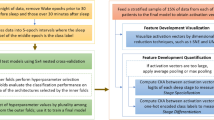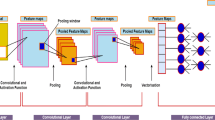Abstract
Sleeping problems have become one of the major diseases all over the world. To tackle this issue, the basic tool used by specialists is the polysomnogram, which is a collection of different signals recorded during sleep. After its recording, the specialists have to score the different signals according to one of the standard guidelines. This process is carried out manually, which can be a high-time-consuming task and very prone to annotation errors. Therefore, over the years, many approaches have been explored in an attempt to support the specialists in this task. In this paper, an approach based on convolutional neural networks is presented, where an in-depth comparison is made in order to determine the convenience of using more than one signal simultaneously as input. This approach is similar to the one made in other problems although, additionally to those models, they were also used as parts of an ensemble model to check whether any useful information can be extracted from processing a single signal at a time which the dual-signal model cannot identify. Tests have been performed by using a well-known dataset called sleep-EDF-expanded, which is the most commonly used dataset as benchmark for this problem. The tests were carried out with a leave-one-out cross-validation over the patients, which ensures that there is no possible contamination between training and testing. The resulting proposal is a network smaller than previously published ones, but it overcomes the results of any previous models on the same dataset. The best result shows an accuracy of 92.67% and a Cohen’s kappa value over 0.84 compared to human experts.





Similar content being viewed by others
References
Acharya UR, Oh SL, Hagiwara Y, Tan JH, Adeli H (2018) Deep convolutional neural network for the automated detection and diagnosis of seizure using EEG signals. Comput Biol Med 100:270–278
Akben SB, Alkan A (2016) Visual interpretation of biomedical time series using Parzen window-based density-amplitude domain transformation. PLoS ONE 11:e0163569
Berthomier C, Drouot X, Herman-Stoïca M et al (2007) automatic analysis of single-channel sleep EEG: validation in healthy individuals. Sleep 30:1587–1595
Boashash B, Ouelha S (2016) Automatic signal abnormality detection using time-frequency features and machine learning: a newborn EEG seizure case study. Knowl Based Syst 106:38–50
Chollet F (2017) Xception: deep learning with depthwise separable convolutions. In: 2017 IEEE conference on computer vision and pattern recognition (CVPR)
Chong Y, Fryer CD, Gu Q (2013) Prescription sleep aid use among adults: United States, 2005–2010. NCHS Data Brief 127:1–8
Dahl GE, Yu D, Deng L, Acero A (2012) Deep neural networks for acoustic modeling in speech recognition: the shared views of four research groups. IEEE Trans Audio Speech Lang Process 20:30–42
Deng L, Yu D (2014) Deep Learning: Methods and Applications. Found Trends® Sig Process 7(3–4):197–387
Doroshenkov LG, Konyshev VA, Selishchev SV (2007) Classification of human sleep stages based on EEG processing using hidden Markov models. Med Tekh 41:24–28
Fernández-Blanco E, Rivero D, Gestal M, Dorado J (2013) Classification of signals by means of genetic programming. Soft Comput 17:1929–1937
Ford ES, Wheaton AG, Cunningham TJ et al (2014) Trends in outpatient visits for insomnia, sleep apnea, and prescriptions for sleep medications among US adults: findings from the National Ambulatory Medical Care survey 1999–2010. Sleep 37:1283–1293
Fukushima K (1980) Neocognitron: a self-organizing neural network model for a mechanism of pattern recognition unaffected by shift in position. Biol Cybern 36:193–202
Goldberger AL, Amaral LA, Glass L et al (2000) PhysioBank, PhysioToolkit, and PhysioNet: components of a new research resource for complex physiologic signals. Circulation 101:E215–E220
Goodfellow I, Pouget-Abadie J, Mirza M, Xu B, Warde-Farley D, Ozair S, Courville A, Bengio Y (2014) Generative adversarial nets. In: Advances in neural information processing systems. pp 2672–2680
Goodfellow I, Bengio Y, Courville A (2016) Deep learning. MIT Press, Cambridge
Hassan AR, Bhuiyan MIH (2016a) Automatic sleep scoring using statistical features in the EMD domain and ensemble methods. Biocybern Biomed Eng 36:248–255
Hassan AR, Bhuiyan MIH (2016b) Computer-aided sleep staging using complete ensemble empirical mode decomposition with adaptive noise and bootstrap aggregating. Biomed Signal Process Control 24:1–10
Hassan AR, Bhuiyan MIH (2016c) A decision support system for automatic sleep staging from EEG signals using tunable Q-factor wavelet transform and spectral features. J Neurosci Methods 271:107–118
Hassan AR, Bhuiyan MIH (2017) Automated identification of sleep states from EEG signals by means of ensemble empirical mode decomposition and random under sampling boosting. Comput Methods Progr Biomed 140:201–210
Hassan AR, Subasi A (2016) Automatic identification of epileptic seizures from EEG signals using linear programming boosting. Comput Methods Progr Biomed 136:65–77
Hassan AR, Subasi A (2017) A decision support system for automated identification of sleep stages from single-channel EEG signals. Knowl Based Syst 128:115–124
Hassan AR, Bashar SK, Bhuiyan MIH (2015a) On the classification of sleep states by means of statistical and spectral features from single channel electroencephalogram. In: 2015 International conference on advances in computing, communications and informatics (ICACCI)
Hassan AR, Bashar SK, Bhuiyan MIH (2015b) Automatic classification of sleep stages from single-channel electroencephalogram. In: 2015 Annual IEEE india conference (INDICON)
Hinton G (2009) Deep belief networks. Scholarpedia J 4:5947
Hsu Y-L, Yang Y-T, Wang J-S, Hsu C-Y (2013) Automatic sleep stage recurrent neural classifier using energy features of EEG signals. Neurocomputing 104:105–114
Iber C, Ancoli-Israel S, Chesson AL, Quan SF (2007) Respiratorische regeln. Das AASM-Manual zum Scoring von Schlaf und assoziierten Ereignissen. 3:51–57
Kemp B, Zwinderman AH, Tuk B et al (2000) Analysis of a sleep-dependent neuronal feedback loop: the slow-wave microcontinuity of the EEG. IEEE Trans Biomed Eng 47:1185–1194
Kingma D, Ba J (2015) Adam: a method for stochastic optimization. In: International conference on learning representation
Krizhevsky A, Sutskever I, Hinton GE (2017) ImageNet classification with deep convolutional neural networks. Commun ACM 60:84–90
Kuncheva LI (2002) A theoretical study on six classifier fusion strategies. IEEE Trans Pattern Anal Mach Intell 24:281–286
Kuncheva LI, Alpaydin E (2007) Combining pattern classifiers: methods and algorithms. IEEE Trans Neural Netw 18:964
LeCun Y, Bottou L, Bengio Y, Haffner P (1998) Gradient-based learning applied to document recognition. Proc IEEE 86:2278–2324
LeCun Y, Bengio Y, Hinton G (2015) Deep learning. Nature 521:436–444
Liang S-F, Kuo C-E, et al (2011) A rule-based automatic sleep staging method. In: 2011 Annual international conference of the IEEE engineering in medicine and biology society
Liang S-F, Kuo C-E, Hu Y-H et al (2012) Automatic stage scoring of single-channel sleep EEG by using multiscale entropy and autoregressive models. IEEE Trans Instrum Meas 61:1649–1657
McLachlan G (2004) Discriminant analysis and statistical pattern recognition, vol 544. Wiley
Mosteller F, Tukey JW (1968) Data analysis, including statistics. In: Handbook of social psychology, vol 2, pp 80–203
Norman RG, Pal I, Stewart C et al (2000) Interobserver agreement among sleep scorers from different centers in a large dataset. Sleep 23:1–8
O’Reilly C, Gosselin N, Carrier J, Nielsen T (2014) Montreal archive of sleep studies: an open-access resource for instrument benchmarking and exploratory research. J Sleep Res 23:628–635
Quan SF, Howard BV, Iber C et al (1997) The sleep heart health study: design, rationale, and methods. Sleep 20:1077–1085
Ranjan R, Patel VM, Chellappa R (2017) HyperFace: a deep multi-task learning framework for face detection, landmark localization, pose estimation, and gender recognition. IEEE Trans Pattern Anal Mach Intell 41:121
Rechtschaffen A, Kales A (1968) A manual of standardized terminology, technique and scoring system for sleep stages of human sleep. Brain Information Service, Los Angeles
Rivero D, Fernandez-Blanco E, Dorado J, Pazos A (2015) Classification of two-channel signals by means of genetic programming. In: Proceedings of the companion publication of the 2015 annual conference on genetic and evolutionary computation. ACM, pp 1319–1325
Ronzhina M, Janoušek O, Kolářová J et al (2012) Sleep scoring using artificial neural networks. Sleep Med Rev 16:251–263
Russakovsky O, Deng J, Su H et al (2015) ImageNet large scale visual recognition challenge. Int J Comput Vis 115:211–252
Sakhavi S, Guan C, Yan S (2018) Learning temporal information for brain–computer interface using convolutional neural networks. IEEE Trans Neural Netw Learn Syst 29:5619–5629
Smirnov N (1948) Table for Estimating the Goodness of Fit of Empirical Distributions. Ann Math Stat 19:279–281
Sors A, Bonnet S, Mirek S et al (2018) A convolutional neural network for sleep stage scoring from raw single-channel EEG. Biomed Signal Process Control 42:107–114
Srivastava N, Hinton G, Krizhevsky A et al (2014) Dropout: a simple way to prevent neural networks from overfitting. J Mach Learn Res 15:1929–1958
Stranges S, Tigbe W, Gómez-Olivé FX et al (2012) Sleep problems: an emerging global epidemic? Findings from the INDEPTH WHO-SAGE study among more than 40,000 older adults from 8 countries across Africa and Asia. Sleep 35:1173–1181
Supratak A, Dong H, Wu C, Guo Y (2017) DeepSleepNet: a model for automatic sleep stage scoring based on raw single-channel EEG. IEEE Trans Neural Syst Rehabil Eng 25:1998–2008
Taigman Y, Yang M, Ranzato M’aurelio, Wolf L (2014) DeepFace: closing the gap to human-level performance in face verification. In: 2014 IEEE conference on computer vision and pattern recognition
Tsinalis O, Matthews PM, Guo Y (2016) Automatic sleep stage scoring using time-frequency analysis and stacked sparse autoencoders. Ann Biomed Eng 44:1587–1597
Tzallas AT, Tsipouras MG, Fotiadis DI (2007) A time-frequency based method for the detection of epileptic seizures in EEG recordings. In: Twentieth IEEE international symposium on computer-based medical systems (CBMS’07)
Übeyli ED (2010) Lyapunov exponents/probabilistic neural networks for analysis of EEG signals. Expert Syst Appl 37:985–992
Vural C, Yildiz M (2008) Determination of sleep stage separation ability of features extracted from EEG signals using principle component analysis. J Med Syst 34:83–89
Wendt SL, Welinder P, Sorensen HBD et al (2015) Inter-expert and intra-expert reliability in sleep spindle scoring. Clin Neurophysiol 126:1548–1556
Wilcoxon F (1945) Individual comparisons by ranking methods. Biom Bull 1:80
World Health Organization (2015) Global recommendations on physical activity for health. World Health Organization, Geneva
Yosinski J, Clune J, Bengio Y, Lipson H (2014) How transferable are features in deep neural networks? In: Ghahramani Z, Welling M, Cortes C, Lawrence ND, Weinberger KQ (eds) Advances in neural information processing systems, vol 27. Curran Associates Inc., Red Hook, pp 3320–3328
Zhu G, Li Y, Wen PP (2014) Analysis and classification of sleep stages based on difference visibility graphs from a single-channel EEG signal. IEEE J Biomed Health Inform 18:1813–1821
Acknowledgements
The authors would like to thank the support from Nvidia Corporation., which granted the GPU used in this work. They also acknowledge the support from the CESGA, where many of the preliminary tests were run. This work is supported by the project granted by the Carlos III Health Institute (PI17/01826) within the Spanish National plan for Scientific and Technical Research and Innovation 2013–2016 and the European Regional Development Funds (FEDER). The authors would also like to acknowledge the support from the Galician Government in the form of Grants (ED431D 2017/23, ED431D 2017/16, ED431G/01) and that from the European Union in the form of ERDF funds.
Author information
Authors and Affiliations
Corresponding author
Ethics declarations
Conflict of interest
Besides the affiliation of the researchers, there is no other conflict of interest.
Human and animal rights
This article does not contain any studies with human participants or animals performed by any of the authors. Data used in this work were publicly available and granted by the original database owner.
Additional information
Communicated by V. Loia.
Publisher's Note
Springer Nature remains neutral with regard to jurisdictional claims in published maps and institutional affiliations.
Rights and permissions
About this article
Cite this article
Fernandez-Blanco, E., Rivero, D. & Pazos, A. Convolutional neural networks for sleep stage scoring on a two-channel EEG signal. Soft Comput 24, 4067–4079 (2020). https://doi.org/10.1007/s00500-019-04174-1
Published:
Issue Date:
DOI: https://doi.org/10.1007/s00500-019-04174-1




